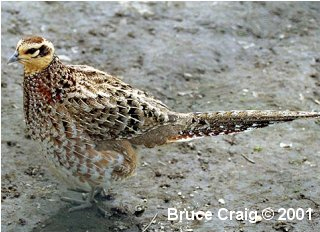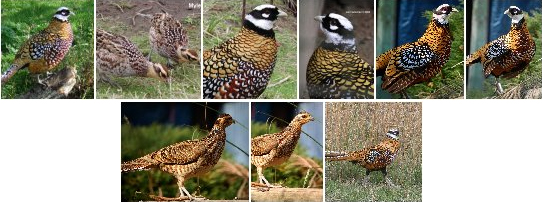 Other Names: Long-tailed Pheasant
Other Names: Long-tailed Pheasant
Range: Central China, range has been greatly reduced. Unsuccessful attempts to introduce into North America, Hawaii, England and France. Birds are still released in these areas for sport, but breeding information is unknown.
Subspecies: None.
Habitat: Forested mountains.
Description: A very familiar and well known pheasant in captivity. The males are known to grow very long tails, up to 6 feet in some cases! The crown, chin and back of head is white with a black band covering the face, eyes and extending to the back of the head. Another black band around the neck seperates the head from the black-tipped, yellow-buff plumage that is on the mantle and the back and extends to the base of the tail. The upper breast is darker chestnut to black; lower breast and side feathers are white, tipped with black. The tail is very long, white with black bars.
There is a great deal of plumage variations in captive birds. Some are seen with black feathers on the crown and the black band on the face may extend below the mandible. Other birds are seen with a darker chestnut color on the body. Some breeders feel that inbreeding over the years has contributed to this.
Description, Female: The hen is drab as in most pheasants and is smaller than the male. Her face and throat are buff, with a brown crown and band behind her eye. The overall markings are mottled brown, buff and white, which hides her very well when nesting. The tail is long and barred with buff and brown.
Status in Aviculture: Very common; most commonly seen species of the genus Syrmaticus in captivity. Due to the rapid decline of the wild population, captive breeding and genetic diversity becoming very important.
Breeding Season: Begins in late April or early May. We have had hens lay into early July.
Breeding Age: First year.
Clutch Size: 7 to 14 olive colored eggs.
Incubation Period: 24-25 days.



